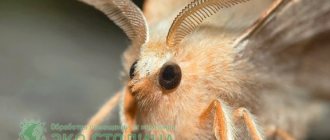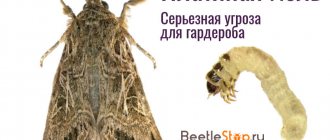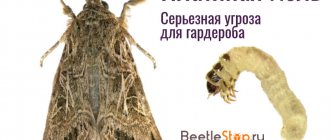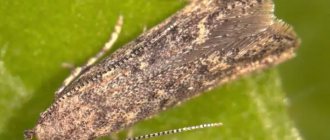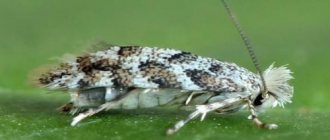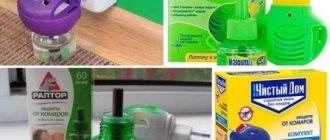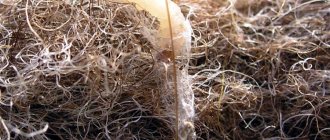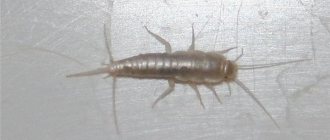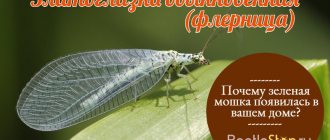The moth can adapt quite quickly to various living conditions, so this insect can be found on any continent. Adults and larvae, depending on the species, vary in size and color - some are large and bright, others are small and unsightly. This article will help you determine which type of pest you are dealing with and what to expect from it.
Description, life cycle and reproduction
The moth looks inconspicuous: it is a small butterfly of golden yellow or straw color, the wingspan is 15 mm. The insect is afraid of daylight, so it leads a nocturnal lifestyle. During her life cycle, the female manages to lay about 300 eggs. Flying butterflies do not harm clothes. Their digestive system does not function; they only consume water. The danger is posed by small caterpillars - the larvae of household moths.
Knowing how the pest reproduces, you can take preventative measures. At home, the insect prefers to breed in the folds of clothing. Females love dry and warm habitats. After mating, the female is ready to lay eggs within four hours. The higher the temperature, the faster the larvae will hatch from the eggs. Moths in apartments feed on keratins, which they obtain from home textiles: woolen fabrics, fur coats, fabric pads in furniture, curtains and carpets. She is especially attracted to worn clothes with traces of dirt and sweat.
The larvae have a translucent or light yellow body color, due to this the entire contents of their stomach are visible. There are eight short legs on the abdomen; the caterpillar's head is brown. The larvae reach a length of 12 mm, have powerful jaws and a voluminous digestive system. Thanks to this, clothes quickly become unusable, leaving gnawed tracks on the product.
If you see a flying clothes moth, then it is a male. Females do not know how to fly, they stay in one place, and the males fly to them themselves, finding them by a specific smell.
Who is this moth?
Moths are insects of the order Lepidoptera, which are characterized by their small size and lead a mostly twilight lifestyle. It is the larvae of these insects that are serious pests, and the adults, having reached sexual maturity, only mate and lay eggs.
Oral organ
Moths are similar to butterflies in many ways, but one of their most striking distinguishing features is their lack of a proboscis. Butterflies use this organ to obtain nectar, which is hidden quite deep in the inflorescences of plants. Moth larvae, being primitive creatures and less fastidious in food, have powerful jaws that allow them to chew even fruit seeds and plant seeds.
So, why don't moths have a proboscis? The answer is quite simple. These insects simply do not need it, since while still caterpillars, they consume food with the help of their oral apparatus and accumulate energy reserves in the body.
Growing up, moths not only lose the ability to eat, but also cannot digest food. In adulthood, their main task is to breed offspring.
For this reason, it makes no sense to fight with adults. It is the larvae that spoil your furniture, clothes and feed on cereals hidden in the kitchen.
Interesting fact! Some species that reach sexual maturity may still have jaws, but even then they will not pose a potential threat. This means that they have not yet fully evolved.
Lifespan
Now we need to find out how long the moth lives. The duration of existence of an winged individual is quite short and can be about 2-4 weeks, which depends on the type of insect. During this period, they move very little and fly only at dusk, which is due to their complete defenselessness against predators and poorly developed wings. But before puberty there are two stages:
- the female lays eggs, from which caterpillars appear at a temperature of +20°C after 13-15 days;
- The larvae wrap themselves in a cocoon, which is made from nutritious material, and live and develop in it for a relatively long period of time - from 3 to 10 months.
Based on the duration of the above stages and summing them up, it is easy to calculate the life cycle of a moth and what damage they can cause during their existence.
Types of flying insects
Household moth is a general term for all varieties of insects that can get into an apartment and ruin your favorite clothes and groceries. They differ in their feeding habits and external characteristics. There are six types.
- Clothes moth. Light yellow butterfly with a lilac tint on the wings. The larvae of the parasite are white, with powerful jaws, and feed on soiled areas of clothing, gnawing them to holes.
- Fur moth. A white moth with black spots on its wings. Caterpillars eat products made of fur, velvet and wool. Standard cellophane clothing bags do not pose a barrier for them.
- Furniture moth. Butterfly with yellow-gray wings. The larvae eat sofa upholstery and fur items. They live inside furniture or in closets.
- Buffalo bug. The moth is dark brown in color with specks on the wings. Lives in carpeting, gradually eating fluffy pile.
- Wood moth. A small moth that climbs into apartments for the winter.
- Food moth. The butterfly is brown or gray in color, belongs to the moth family, the wingspan does not exceed 15 mm. Lives in the kitchen, eating groceries.
Food moth and its larvae
There are several species that differ in food preferences and the color of their wings up to 10 mm long. For example, the fruit one eats dried fruits, the nut one eats nuts, etc.
The grain moth has off-white wings, the flour moth has a black-brown pattern, and the granary moth has black-orange wings.
Translucent white larvae have 4 pairs of legs on the abdomen, and 2 pairs near the dark head. During growth, the caterpillar becomes smooth and thick if there is enough food. The more fat in the food, the thicker the larva. At 6 weeks she is 1.6-2 cm long to begin pupation.
Causes of appearance and damage caused
Usually people don’t even understand how moths start in an apartment, because all precautions are taken. But it is difficult to completely protect your home from an uninvited guest. There are three ways to introduce the parasite into a living space.
- With shopping. You can introduce the pest yourself when purchasing outerwear made of fur, woolen products, or when purchasing used furniture. Moreover, you will not see the individual itself - moths usually start from larvae in an apartment.
- With pets. Walking cats and dogs can carry moth eggs on their fur. The case is rare, but possible.
- Through ventilation. Butterflies are well versed in the ventilation system. If the clothes moth is infested with your neighbors, then it can get to you through the bars.
The caterpillar stage of the parasite is the destructive stage of the moth's life. The larvae gnaw large holes in warm sweaters and outerwear. Damage can most often be noticed in hidden places: under cuffs or collar. The caterpillar will eat any thing made from natural fibers, and will not refuse synthetic products if they contain at least some percentage of wool.
There is a book moth that doesn’t mind feasting on bindings and pages. When searching for an infestation, be sure to look through magazines and newspapers.
Lifespan
To quickly get rid of insects, you need to know how long an adult moth lives. The duration of the adult life cycle is 14–28 days. An adult moth practically does not move in an apartment or on the street, since it cannot resist predators. The life cycle of pests includes the following stages:
- The adult forms a clutch of eggs.
- After 2-2.5 weeks, if the temperature is 19–20 degrees, worms appear. The development period largely depends on the species. Therefore, it is important for housewives, gardeners and summer residents to know what moths are.
- For normal development, each larva forms a cocoon around itself from nutritional components, in which it lives for 2–9 months. The cocoon acts as protection against temperature fluctuations.
Considering how quickly the moth multiplies, you should start fighting it immediately after detection. After all, it can cause irreparable harm.
How to get rid of moths in an apartment
How to get rid of moth larvae? In just a month of active existence, the caterpillar is capable of destroying clothes in the dressing room. And if eggs nest on neighboring products, then the epic may drag on. The fight against the parasite must be carried out in four stages.
- Get rid of damaged items. From the closet where the moth nest was, throw out all the clothes.
- Clean all corners. Thoroughly vacuum every nook and cranny of the closet.
- Disinfect the shelves. Wash the shelves and interior walls with soap and water. Then wipe the cabinet with a vinegar solution and spray an aerosol inside.
- Process whole things. Throw the clothes into the washing machine and wash in hot water. Place items that cannot be heat treated in a plastic bag and put them in the freezer for a day. Then wash on an acceptable cycle.
Chemicals and traps
Professional remedies are considered the most effective to get rid of moths in the house. The most popular drugs include the following.
- Fumigator. It is an electrical device into which an insecticide is placed in a plate. The device is plugged in, and when heated, the plate begins to evaporate. The smell can destroy moths at any stage of development in just a few days. The most popular fumigators are “Raid” and “Raptor”.
- Sections. Thin plates with a chemical inside. The product gradually evaporates, scaring away adults. They are not capable of destroying the parasite larvae. The most effective sections are “Raptor” and “Moskitol”.
- Aerosols. Spray inside the closet, on clothing, carpets and furniture lining. It copes well with moths and larvae, but the toxic composition is harmful to humans and pets. It is best to leave the room during treatment and thoroughly ventilate it after the procedure. The most effective aerosols: “Armol”, “Raptor”, “Moskitol”, “Extramit”. The effect of the spray lasts for a year.
- Traps. Filled with pheromones, they attract the attention of adults. Males fly into a sticky trap and remain in it forever, since it is made on the basis of a sticky substance. The main advantage of this product is its natural composition and lack of odor.
- Case. Designed to protect expensive outerwear. The cover is impregnated with chemicals that repel larvae and adults.
- Liquid preparations. Used to process carpets, curtains and furniture upholstery. Treated items are put into a case for prevention.
The larvae adhere weakly to fabric fibers. To get rid of them, shake things on the balcony or outside.
Smelling household products
If you avoid using chemicals, then focus on folk remedies to get rid of moths in your clothes closet. It is not necessary to poison yourself with toxic fumes; moths are afraid of the pungent odors of herbs and flowers.
- Lavender. Pack dry inflorescences in small bags and place them on the shelves of your wardrobe. The aroma of lavender will scare adults away from textiles.
- Garlic. Place a clove of garlic in your fur coat and coat pockets. A pungent smell will force butterflies to change their habitat.
- Laundry soap. Cut the soap into pieces, put it in your pockets, on the shelves of your dresser. Butterflies will not fly to the closet.
- Geranium. Clothes moths cannot tolerate the smell of the flower. It is enough to place it on the windowsill and ventilate the dressing room from time to time. Over time, the butterflies will leave the room.
- Dill. The female cannot stand the smell of dill. Dry the plant, pack it in rag bags, and place it in secluded corners of the apartment.
- Tansy. Dried tansy inflorescences will fill the dressing room with aroma, this will save the contents of the cabinets from pest attacks.
- Oils. Soak cotton sponges in aromatic oils of walnut, geranium or lavender and place them on the shelves in your closet. This is an excellent prevention against the reproduction of adult individuals.
- Citrus. Place fresh orange or lemon peels in the chest of drawers where you store your favorite sweaters.
Clothes moths at any stage of development cannot tolerate sudden temperature changes. Don't forget to ventilate the room more often. To save your favorite things, take them out into the cold. Or place in a hot environment, the temperature should be above 30°C.
Methods of combating household (clothes, fur coat, furniture) moths
You can use chemicals that are sold in hardware stores. Their selection is wide, which allows you to choose the best option according to your requirements and desires.
The most effective insecticides are those that have a quick destructive effect. But it is not enough to destroy only the butterflies; it is also necessary to eliminate the egg-laying eggs they leave behind.
The most popular means:
- sprays, aerosols,
- fumigators,
- repellent sections.
Sprays, aerosols
The insecticide solution is in a special cylinder under pressure, which makes it possible, when the valve is pressed, to evenly distribute the substance over the surface and clothing. Together with the air, the toxic substance enters the body of the moth, which causes the death of the individual.
Treatment should be repeated at intervals of 1 week until all insects in the room are destroyed.
The disadvantage of using sprays and aerosols is that they are toxic to humans and pets. It is worth taking the animals out of the room in advance, as well as covering the aquarium with film, and taking protective measures when spraying. 30 minutes after treatment, ventilate the room.
Popular aerosol products:
- "Armol",
- "Raptor"
- "Clean house".
Fumigators
These products are often used against mosquitoes, but they are also effective against moths. When the device is turned on, toxic vapors evaporate from a special tablet or plate.
Be sure to read:
Fleas in the house: how to get rid of them yourself, the best folk and special remedies
To destroy in a closet or in a sofa, the fumigator should be placed near the furniture. It is worth replacing the plates or tablets with new ones every day.
Toxic vapors in the air are low in concentration; the device is completely safe for humans and pets. Destruction will require a ten-day course of continuous use.
Common remedies:
- "DiK-3"
- "Raid",
- "Moskitol".
Repellent sections
A more gentle method of getting rid of uninvited guests is the use of special deterrent devices. They are made in the form of pendants, bags, plates that emit an unpleasant aroma for the pest.
They should be placed on closet shelves or hung on hooks, and placed next to the affected furniture. The emitting odor forces insects to leave their usual shelter.
The most effective means:
- "Combat"
- "Shield",
- "StopMol"
- "Moskitol".
What does it look like
Moths, whose larvae eat things made from natural fabrics, have a number of differences from other clothing pests.
The appearance characteristics of this insect are as follows:
- The body length of the parasite is no more than seven mm, the length of the wings is one and a half cm.
- The color of the wings is golden, and there are reddish bristly hairs on the head.
- A developed oral apparatus is present exclusively in larvae; adult butterflies, whose total lifespan is no more than seven days, do not need food.
- Larval development occurs over several weeks. Under moderate temperature conditions, the development cycle is about 200 days.
- Female butterflies do not fly, although their wings are developed.
Knowing what moths that eat clothes look like, you can promptly identify the pest and take measures to destroy it, which will avoid damage to textiles. It is important to determine the species of the insect, since the methods of getting rid of certain varieties have some differences.
Introduction
House moth
Moth is a rather harmful insect that prefers to consume keratin contained in
wool and natural fur products. The insect adapts well to different living conditions. Thanks to this, it is found on almost every continent. There are a large number of insect species that differ from each other. The article will discuss the main types of moths and their distinctive characteristics.
How to protect clothes
To protect your wardrobe from parasites, it is important to know what repels moths from clothes.
It is advisable to use folk remedies that do not harm things, human health, or animals.
You can save and protect clothes from moths using the following methods:
- Powders. The assortment of specialized stores includes powders based on substances that repel parasites. Such powders do not harm humans, and to obtain the desired effect, it is enough to place a bag of the substance in the closet.
- You can make powders that will help protect your wardrobe from pest invasions yourself. To do this, collect wormwood or lavender herbs, dry, grind, and place in the closet. Plant raw materials do not harm humans and do not damage the appearance of clothing.
Moth caterpillars prefer to feed on natural fur, which jeopardizes an expensive wardrobe item - fur coats. To avoid the appearance of pests, before putting the item away for summer storage, it is recommended to put the above products in its pockets.
It is important to remember that regular cleaning and washing of clothes will help prevent pests.
You also need to periodically ventilate your wardrobe, wardrobes, and apartment. This measure will help identify pests and reduce their numbers.
Prevention of occurrence
To prevent the reappearance of this pest in the apartment, you need to follow simple rules of prevention:
- When purchasing items and products, carefully inspect them for larvae.
- Long-term storage clothing must be periodically ventilated and dried.
- Used furniture should be vacuumed more often and treated with Antimol.
- Ventilate kitchen and wardrobes, periodically leaving their doors open.
- After washing, be sure to iron your clothes.
By following simple recommendations, you can not only destroy moths indoors, but also prevent their appearance. This inconspicuous insect can cause serious damage to things and products.
By strictly following the recommendations, you can protect your home from this scourge.
